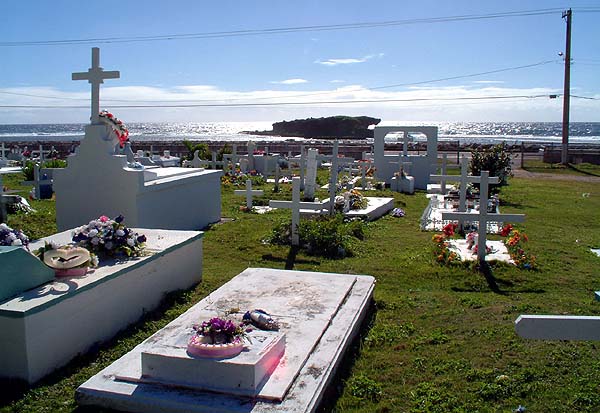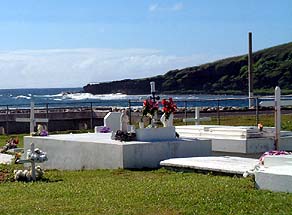 |
 |
 |
 |
||||
|
|
|
|
|
|
|
|
|
|
|
|||||||
|
|
|
|
|
|
|
"If you look at the cemeteries around the island," Joe points out, "especially in the south, the cemeteries are facing the waters of the ocean. The old people say that that’s how you bury your loved ones. And then archaeological findings also prove that when there are burial sites, their feet face the ocean. We can say now that the Church has taken the Chamorros’ burial rituals and has done it by also placing a cross on top, so it becomes a Catholic burial. "Now when you go further north, you’re going to start to see the cemeteries not necessarily facing the water. Does that have anything to do with foreign influence? Yes it does, because the first cemetery that does not face the water is a cemetery in Agat, which is the village closest to the military bases, and the influence from the military has had a great impact on that village."
|
||
|
|
||
|
"When the Spanish describe the ancient Chamorro burials," Anne explains, "the accounts say that once a person got sick, then people would start bringing food already to the family to help them out, and for the sick person. And then once the person died, the more food would come, which is pretty much what the rosaries are today, just people bringing more food. And the ancient accounts describe that this would go on for so many days. "Then when the body needed to be buried, because it was beginning to smell, then they would bury it at the family residence, usually beneath the house or in the area of the latte stones. That’s why even to this day, with latte sites, Chamorros are very cautious any time they are near a latte site, because there’s the connection that around lattes are burials. So they would bury the body, and bury it holding or with any artifacts that were close to that person, or that the person was known for."
|
An example of ancient Chamorro jewelry.
|
|
|
"In some of the ancient burials that have been dug up, they have found jewelry or fishing implements, or different things that the person was known for. And then the way the accounts describe it, which is very similar, is that when the burial is happening, it would be led by the eldest women who would come surround the body and wail for hours, you know, 'Who’s going to do your fishing? Who’s going to take care of your family?' -- things like that. They would lead them to wailing. "When they were about to bury the body, after the wailing, then people would put flowers in the grave or in pieces of cloth or woven things just to cover the body, and then the burial would be complete. The similarity to the modern burial is very close. When you go to the cemeteries, before they bury the body it’s all the old women wailing, except it’s just not hours. Then right before they bury the body, people put flowers into the grave. "Or if the body is going up into one of those 'condominiums,' then they put the flowers on top of the casket and they try to squeeze it all in, so they bury the body with all the flowers that people have brought, and then they close it."
|
|
|
|
|
"When Chamorros were buried," Anne continues, "the skulls of the most respected were excavated after the bodies decomposed, and kept either in your home or kept by the makahna to pray to that person later. So the thinking was, if someone had been a good warrior in life, that even after his death, you could still kind of tap into his spirit. Not every person's skull was kept, but perhaps only those who had been highly respected in life and whose wisdom would still be called on to guide the clan. "It’s not much different from worshipping saints. What we do today is call on the powers of certain people because of what they did in the past, and we believe that their works in the past, their character in the past can help us in the present. "But to the Spanish, the Chamorro practice was all the influence of the devil, and so in the accounts, the priests and Father San Vitores told the soldiers to destroy the skulls, burn them, crush them. And I just can’t imagine how offensive that must have been to Chamorro people, because these were not generic skulls. These are skulls of someone’s grandmother, or someone’s ancestor, so that would have been extremely offensive."
|
||
|
|
||
|
“The cemetery is used by Malojloj and Inarajan" says Therese. "It’s a pretty old cemetery. There are bodies that they’ve exhumed and placed in different areas only because they were piling one on top of another. As the years go on, the cemetery gets bigger and bigger. I really don’t know how old that cemetery is but I know it’s been there quite a long time. My grandfather used to be the caretaker of St. Joseph,and he was also the person that everybody went to see when they needed somebody buried in the cemetery. He knew where the locations were, where family members were, and where was the best place for their loved one to rest. “Then during one of the recent typhoons in the '90’s, the water came in to where the cemetery is. And I know for a fact that before the typhoon came, there were a couple of people that were just buried in freshly dug graves. And when the water came in, the caskets floated up. It was a hard time for the people of Inarajan, because they had to go back and identify loved ones. You know, after burying them and thinking they are resting in peace; then going back and having to look at them again. It really was very hard."
|
|
|
|
"I’ll tell you Typhoon Russ, Typhoon Yuri," Bill exclaims, "it was like a war just actually happened there, with the devastation. It was quite emotional, particularly for those newly buried loved ones and I understand that there is a coffin still stuck at a bridge going down to Merizo. One of the coffins is still stuck in there. There’s no way that it could be taken out. One evening one of the guys was actually fishing and saw part of the head … and can you imagine, it’s after the typhoon and it was a while after the typhoon and here he was fishing and that’s what he caught. Can you imagine that?
|
|
|
|
|
"But people see that, people are very resilient," Bill adds. "They picked up the pieces. It was awful but it didn’t take a long time to get back to normal life. And this reflects on the chenchule’ system." We will hear more about this chenchule’ system in the Footprints chapter. This is one of the traditional Chamorro values that remains strong today. And one of the places where these values are learned is on family ranches.
|
||
|
|
||
|
|
|
|
|
|

|
| Inarajan Home | Map Library | Site Map | Pacific Worlds Home |
|
|
|
|
|
|
|
|||
| Copyright 2003 Pacific Worlds & Associates • Usage Policy • Webmaster |
|||







